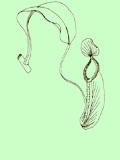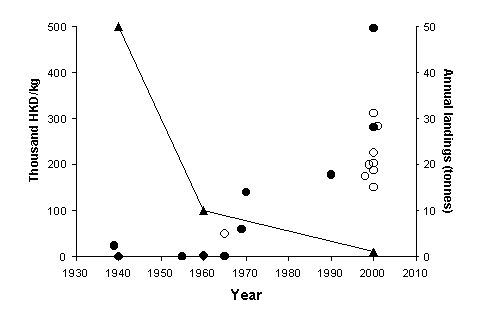

 |
 |
 |
Vertebrates
The case of the disappearing croaker, the Chinese bahaba, Bahaba taipingensis
by Yvonne Sadovy and William Cheung Wai Lung
In the early 1930s, a new species of giant croaker became known to western scientists when Herre described the giant yellow croaker, now known as Bahaba taipingensis (Herre, 1935; Lin 1935) "In the markets ……of China I have seen sciaenids a meter or more in length which I am confident belong to undescribed species. Unfortunately I had no way of preserving them at the time and no small specimens were to be found……. ". By 1988, this species was listed as a ‘State Protected Species’ in the People’s Republic of China (PRC) (Bureau of Fisheries Management and Fishing Port Superintendence). It was noted as commercially extinct in Hong Kong in 1997 but is not protected locally. The increasing rarity of this fish in the last 4 decades has conferred upon it such high value that fishers have referred to it as "soft gold" and the top current retail market value of the swimbladder, weight for weight, exceeds that of gold by up to 7 times. Its numbers are so reduced that it may already be too late to save this species from extinction. It may be the first documented example of the near extinction of a highly fecund marine fish species (those that produce hundreds of thousands to millions of eggs yearly).
Since the biology and fishery of the giant yellow croaker are sparsely documented we conducted a series of interviews with 13 experienced fishers and 4 traders in Taiping (within the Pearl River estuary) and Hong Kong, carried out reviews of the English and Chinese literature and communicated directly with 10 scientists from academia and government departments in the PRC. This account is an extract from the results of this study.
The giant yellow croaker, or Chinese bahaba, is one of the two largest of all croakers (Sciaenidae) and a modest fishery for it has existed for decades. It attains 2 m and at least 100 kg and is limited to the coast of China, from the Yangtze River to Hong Kong (Chu et al., 1963). It enters estuaries seasonally to spawn in large aggregations during which time the fishery is active. In western Hong Kong, croaker aggregations were especially important in the 1960s: "In February and March occurs the peak run of the giant croakers Nibea diacanthus and Bahaba flavolabiata (=taipingensis). Trawlers set their nets and charge dead into the immense schools of these fish, making incredible hauls" (Anderson 1970). Also referring to these two giant croakers: "Trawls of tons are not unknown; boats have made $30,000 (HKD) in a single haul. They are the mainstay of the trawlers"(Anderson, 1969). Several gears were used including specialized nets (Ting Ji) of mesh size 37-40 cm and length 90 m. During the 1950s-1960s, 30-40 boats, specialized in catching giant croakers, were active annually in Hong Kong.
Estimates of landings in the last 4-6 decades from estuarine areas suggest massive declines which are inversely related to rising prices of its highly appreciated swimbladder (the ‘maw’ is valued for medicinal properties) (Fig. 1). In Hong Kong of the late 1930s, for example, 50 t were landed annually but by the 1990s, only small fish (< 30 kg) were sporadically taken, with the rare larger individual (>50 kg). Swimbladder market value (per kg) increased from little more than a handful of US$ in the late 1930s to anywhere between US$ 20,000-64,000 in 2000 (Fig. 1).
 |
| Figure 1. Swimbladder market prices and estimated annual landings of B. taipingensis in HK and elsewhere in the PRC from 1939-2000. Swimbladder market prices in HK (closed circles) and elsewhere in the PRC (open circles) were estimated and Renminbi (RMB) converted to HK dollars (HKD). Landings (solid line and triangles) were estimated from published accounts and fisher interviews. |
There is little doubt that the giant yellow croaker has become critically reduced and may well be threatened with extinction throughout its geographic range, unless significant refugia exist offshore. In the Pearl River estuary, declines in landings cannot be attributed to reduction in fishing effort for in Taiping approximately 100-200 boats still seek this species on its spawning ground because of its high value. The demise of this species has been driven by its inherent biological vulnerability (large size, restricted range and aggregating behaviour), its value. While the possible role of other factors in the decline of this species, such as degradation of estuarine habitat is not known, without doubt fishing pressure has been a major factor.
Bibliography
Anderson, E. N. (1969). Asian Folklore and Social Life Monographs. (ed. L. Tus-K’uang) 1-146 The Orient Cultural Service, Taipei.
Anderson, E. N. (1970) Anthropological Studies No. 4 (ed. W. H. Goodenough) 1-270 American Anthropological Association. Washington, DC.
Chu, Y.T, Lo, Y.L., & Wu, H.L.(1963). A study on the classification of the sciaenoid fishes of China, with descriptions of new genera and species 1-100, 40 plates Science and Technology Press, Shanghai (In Chinese).
Herre, A. W. (1935). A new sciaenid from southeastern China. Lingnan Sci. J. 14(4), 603-604.
Lin, S. Y. 91935). Notes on some important sciaenoid fishes of China. Bull. Chekiang Fish Exp. Station 9(1), 1-30.
|
|
P.14-15 |
|
Porcupine! |
 Copyright © 2000 |